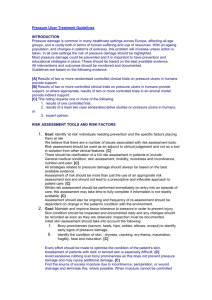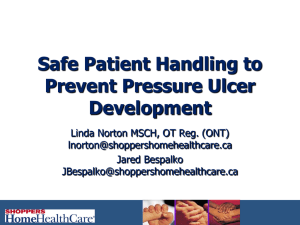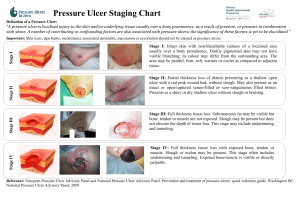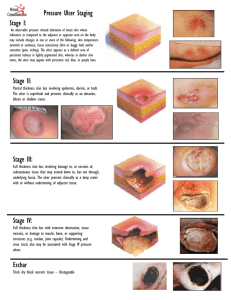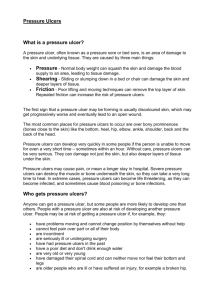Clinical practice Ten top tips: repositioning a patient to
advertisement
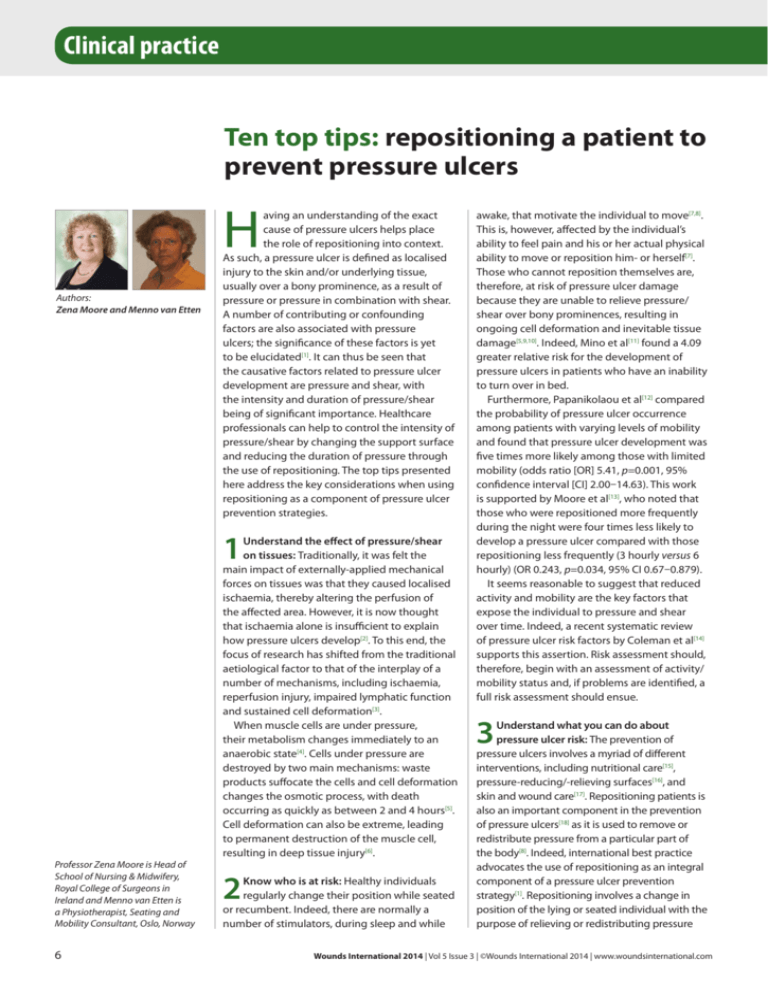
Clinical practice Ten top tips: repositioning a patient to prevent pressure ulcers H Authors: Zena Moore and Menno van Etten aving an understanding of the exact cause of pressure ulcers helps place the role of repositioning into context. As such, a pressure ulcer is defined as localised injury to the skin and/or underlying tissue, usually over a bony prominence, as a result of pressure or pressure in combination with shear. A number of contributing or confounding factors are also associated with pressure ulcers; the significance of these factors is yet to be elucidated[1]. It can thus be seen that the causative factors related to pressure ulcer development are pressure and shear, with the intensity and duration of pressure/shear being of significant importance. Healthcare professionals can help to control the intensity of pressure/shear by changing the support surface and reducing the duration of pressure through the use of repositioning. The top tips presented here address the key considerations when using repositioning as a component of pressure ulcer prevention strategies. 1 Professor Zena Moore is Head of School of Nursing & Midwifery, Royal College of Surgeons in Ireland and Menno van Etten is a Physiotherapist, Seating and Mobility Consultant, Oslo, Norway 6 Understand the effect of pressure/shear on tissues: Traditionally, it was felt the main impact of externally-applied mechanical forces on tissues was that they caused localised ischaemia, thereby altering the perfusion of the affected area. However, it is now thought that ischaemia alone is insufficient to explain how pressure ulcers develop[2]. To this end, the focus of research has shifted from the traditional aetiological factor to that of the interplay of a number of mechanisms, including ischaemia, reperfusion injury, impaired lymphatic function and sustained cell deformation[3]. When muscle cells are under pressure, their metabolism changes immediately to an anaerobic state[4]. Cells under pressure are destroyed by two main mechanisms: waste products suffocate the cells and cell deformation changes the osmotic process, with death occurring as quickly as between 2 and 4 hours[5]. Cell deformation can also be extreme, leading to permanent destruction of the muscle cell, resulting in deep tissue injury[6]. 2 Know who is at risk: Healthy individuals regularly change their position while seated or recumbent. Indeed, there are normally a number of stimulators, during sleep and while awake, that motivate the individual to move[7,8]. This is, however, affected by the individual’s ability to feel pain and his or her actual physical ability to move or reposition him- or herself[7]. Those who cannot reposition themselves are, therefore, at risk of pressure ulcer damage because they are unable to relieve pressure/ shear over bony prominences, resulting in ongoing cell deformation and inevitable tissue damage[5,9,10]. Indeed, Mino et al[11] found a 4.09 greater relative risk for the development of pressure ulcers in patients who have an inability to turn over in bed. Furthermore, Papanikolaou et al[12] compared the probability of pressure ulcer occurrence among patients with varying levels of mobility and found that pressure ulcer development was five times more likely among those with limited mobility (odds ratio [OR] 5.41, p=0.001, 95% confidence interval [CI] 2.00–14.63). This work is supported by Moore et al[13], who noted that those who were repositioned more frequently during the night were four times less likely to develop a pressure ulcer compared with those repositioning less frequently (3 hourly versus 6 hourly) (OR 0.243, p=0.034, 95% CI 0.67–0.879). It seems reasonable to suggest that reduced activity and mobility are the key factors that expose the individual to pressure and shear over time. Indeed, a recent systematic review of pressure ulcer risk factors by Coleman et al[14] supports this assertion. Risk assessment should, therefore, begin with an assessment of activity/ mobility status and, if problems are identified, a full risk assessment should ensue. 3 Understand what you can do about pressure ulcer risk: The prevention of pressure ulcers involves a myriad of different interventions, including nutritional care[15], pressure-reducing/-relieving surfaces[16], and skin and wound care[17]. Repositioning patients is also an important component in the prevention of pressure ulcers[18] as it is used to remove or redistribute pressure from a particular part of the body[8]. Indeed, international best practice advocates the use of repositioning as an integral component of a pressure ulcer prevention strategy[1]. Repositioning involves a change in position of the lying or seated individual with the purpose of relieving or redistributing pressure Wounds International 2014 | Vol 5 Issue 3 | ©Wounds International 2014 | www.woundsinternational.com and enhancing comfort, undertaken at regular intervals[1]. If the individual does not have the ability to reposition him- or herself, he or she requires assistance with this activity of daily living. 4 Figure 1. Patient in the 90° lateral rotation. position Figure 2. The 30° tilt position. Figure 3. Soft fill, newly positioned. Figure 4. Soft fill after 2 hours. The patient has moved due to lack of support. Choose the best patient position for pressure ulcer prevention: There is consensus that certain patient positions are not useful in terms of pressure ulcer prevention[19–22]. The 90° lateral position [Figure 1] has been shown to decrease blood flow and transcutaneous oxygen tension to near anoxic levels and to increase interface pressures. The 90° lateral position should therefore be avoided[1]. The 30° tilt is a patient repositioning technique that can be achieved by rolling the patient 30° to a slightly tilted position with pillow support at the back [Figure 2][19]. Moore et al[13] compared pressure ulcer incidence among older individuals repositioning using the 30° tilt (n=99) compared to the 90° lateral rotation (n=114). A statistically significant difference in pressure ulcer incidence was noted between the groups, with just three patients (3%) developing a pressure ulcer in the 30° group and 13 patients (11%) developing a pressure ulcer in the 90° group (chi square 5.347, p=0.021). The 30° position is thought to be the most appropriate for the patient, as there is less pressure applied to the bony prominences and therefore, blood supply to the weight-bearing area is not completely occluded[19–22]. When using the 30° tilted position, however, check to see that the sacrum is off the bed. Obese patients may need to be turned to a higher angle (45°) in order to offload the sacrum. 5 Understand the ideal frequency of repositioning: There are currently five studies that have explored the timing of repositioning on the incidence of pressure ulcers[7,13,23–25]. Two trials compared the 30º and 90º tilt positions using different repositioning frequencies (2–3 hourly, 3 hourly and 6 hourly), whereas three trials compared alternative repositioning frequencies (2, 3, 4 or 6 hourly). These trials had conflicting results in terms of pressure ulcer incidence, with some showing no statistical differences between the study groups[23–25]. Conversely, others noted a statisticallysignificant difference in pressure ulcer incidence among those turned every 3 hours versus 6 (p=0.021)[13] or 4 hours on a viscoelastic foam mattress versus standard care (p=0.003; OR 0.13; 95%CI 0.03–0.48)[7]. A recent Cochrane systematic review concluded that although there is uncertainty around the evidence, this does not mean these interventions are ineffective, since all comparisons included in the review were grossly underpowered (the Bergstrom study was not included in this review) [26] . Thus, more robust studies are required to clarify the exact repositioning frequency required to prevent pressure ulcers. The joint European Pressure Ulcer Advisory Panel (EPUAP) and National Pressure Ulcer Advisory Panel (NPUAP) guidelines[1] recommend that repositioning frequency should take into account the type of support surface the individual is laying on (in terms of its pressure redistribution qualities) and the individual’s response to the repositioning frequency. When choosing a repositioning schedule, however, it is important to remember that cell death can occur as quickly as in 2 to 4 hours[5]. 6 Consider the health-related quality of life of the individual in all decision making regarding repositioning: The monitoring of quality of life is widely accepted as a means of measuring the effectiveness of social policies, welfare programmes and healthcare[27] and, therefore, should be a prime concern in planning healthcare interventions. Repositioning is intrusive on the individual, and it is really important it is targeted at those who need it, and also that it is used appropriately. Furthermore, the correct use of preventative strategies has important implications for both healthcare efficiency and effectiveness[28]. The Eurobarometer Qualitative Study[29] suggests that patient involvement in their healthcare is fundamental to enhancing the quality of healthcare received. Indeed, the benefits of patient involvement include enhanced motivation to adhere to particular treatment regimens arising from a greater understanding of their specific illness, in addition to a feeling of greater empowerment over self-monitoring of their health status[29]. Patient involvement often includes their relatives and carers, who can help to bridge the communication barrier between the health professional and the patient, as seen in the 1,000 Lives campaign in Wales (www.1000livesplus. wales.nhs.uk/home), thereby helping to ensure that the wishes of the patient are paramount in all decision making. EPUAP and NPUAP[1] suggest there may be certain situations where the patient’s condition precludes the use of repositioning, for example, where moving the patient causes severe pain Wounds International 2014 | Vol 5 Issue 3 | ©Wounds International 2014 | www.woundsinternational.com7 Clinical practice and suffering. In these cases, pain control is a priority in order to facilitate movement. Thus, consideration of the overall goals of care, including the wishes of the patient, are important in planning care that is person-centred and focussed on the needs of the individual[30]. 7 Figure 5. Firm fill, newly positioned. Figure 6. Firm fill, after 2 hours. The position remains unchanged and the patient is still comfortable. Position the individual to ensure stability: In a 30° side lying position, the fill in the cushions used to support the patient has the biggest influence on the patient’s stability. The fill should be firm enough to keep the patient in position, yet soft enough to follow the body contours and to ensure patient comfort. In many facilities, (head) pillows are used to position and stabilise the patient. Under the pressure of body weight, these (fibre-based) pillows will lose air, changing shape; thus the patient’s position will alter, meaning the patient will become unstable[31] [Figures 3, 4]. In Figure 4, note how the patient has moved onto his back due to the failure of the pillow to support him in the original position; the position of the feet was changed by a carer due to patient discomfort). When positioning with soft materials, the patients’ position changes after a short period of time. This instability will make the patient feel insecure and uncomfortable, thereby increasing the need for frequent repositioning[31]. In this situation, one should also suspect that shear forces have increased. Conversely, positioning with firm but soft materials enables the person to maintain his or her position with just a few cushions, avoiding instability and the potential increase in shearing[31] [Figures 5, 6]. and thereby the risk of shear increases[31]. The patient should, therefore, feel secure in the position adopted to avoid shearing forces. 10 Monitor the outcomes of all repositioning the interventions and document findings in a timely fashion: Documentation of repositioning practice within the individual’s clinical notes provides evidence that repositioning has occurred[13]. Furthermore, inclusion of the assessment of outcomes of the repositioning plan also provides evidence for the continuation or alteration of the care plan[13]. The importance of this is multi-fold: to ensure the provision of safe clinical care for the patient, to act as a means of communication between team members, and to fulfil the legal and ethical responsibilities of staff[33]. Indeed, documentation is a fundamental component of clinical practice, with the quality of documentation considered to be an indicator of the quality of care delivered[34]. Additionally, this is the only means by which the healthcare professional provides evidence that care has been planned, implemented and the outcomes assessed[34]. Healthcare professionals should, therefore, be aware of their legal and professional obligations in the provision of clinical care. Documentation is an integral component in the assessment of quality of care; if there is no written record, then there is no evidence of care provision[33]. 8 Position the individual to ensure comfort: In a lying supine position, one of the most important ways of creating comfort is to ensure that the shoulder and pelvic positions are aligned, with the spine in a straight line. This is true for any lying position – in supine, 30° sidelying and 90° side-lying[31] [Figures 7, 8]. A patient in this shoulder–hip–spine-aligned position will be comfortable and stable over a longer period of time. In addition, the legs should be positioned in a slightly flexed, slightly abducted and outwardly rotated position[31,32] [Figure 9]. Figure 7. Pelvis–shoulder–spine alignment in the supine position. 9 Position the individual to ensure security: Repositioning may cause tissue stretch (shear strain)[31]. This shear can cause discomfort and a lack of security. As a result, the patient will strive to change his or her position to become more stable; however, the reverse more often occurs, where the individual’s stability decreases 8 Figure 8. Pelvis–shoulder–spine alignment in 30° sidelying position. Wounds International 2014 | Vol 5 Issue 3 | ©Wounds International 2014 | www.woundsinternational.com Conclusion Figure 9. Pelvis–shoulder–spine alignment. Legs slightly flexed and abducted, rotating outwards. Pressure ulcers are common and costly, and impact negatively on the individual’s health-related quality of life and on the ability of the health service to deliver a costeffective, efficient service. Pressure ulcers can be prevented by identifying those who are most at risk and following this up with the implementation of effective prevention strategies. This article has provided an outline of the top ten tips pertaining to repositioning as a component of pressure ulcer prevention strategies. At the outset, an understanding of the impact of pressure and shear is essential. References 1. European Pressure Ulcer Advisory Panel and National Pressure Ulcer Advisory Panel. Prevention and treatment of pressure ulcers: quick reference guide. National Pressure Ulcer Advisory Panel, 2009. Available at: http://www.npuap.org/wp-content/ uploads/2012/02/Final_Quick_Prevention_for_ web_2010.pdf, accessed 20 August 2014 2. Stekelenburg A, Strijkers GJ, Parusel et al. Role of ischemia and deformation in the onset of compression-induced deep tissue injury: MRIbased studies in a rat model. J Appl Physiol 2007; 102: 2002–11 3. Bader DL, Oomens CW. Recent advances in pressure ulcer research. In: Romanelli M (Ed.). Science and Practice of Pressure Ulcer Management. Springer-Verlag, 2006 4. Gawlitta D, Li W, Oomens CW et al. The relative contributions of compression and hypoxia to development of muscle tissue damage: an in vitro study. Ann Biomed Eng 2007; 35: 273–84 5. Loerakker S, Stekelenburg A, Strijkers GJ et al. Temporal effects of mechanical loading on deformation-induced damage in skeletal muscle tissue. Ann Biomed Eng 2010; 38: 2577–87 6. Gefen A, Van Nierop B, Bader D et al. Strain-time cell-death threshold for skeletal muscle in a tissue-engineered model system for deep tissue injury. J Biomech 2008; 41: 2003–12 7. Defloor T, De Bacquer D, Grypdonck MH. The effect of various combinations of turning and pressure reducing devices on the incidence of pressure ulcers. Int J Nurs Stud 2005; 42: 37–46 8. Krapfl L, Gray M. Does regular repositioning prevent pressure ulcers? J Wound Ostomy Continence Nurs 2008; 36: 571–7 9. Stekelenburg A, Gawlitta D, Bader DL et al. Deep tissue injury: how deep is our understanding? Arch Phys Med Rehab 2008; 89: 1410–3 10. Ceelen KK, Stekelenburg A, Loerakker S et al. Compression-induced damage and internal tissue strains are related. J Biomech 2008; 41: 3399–404 11. Mino Y, Morimoto S, Okaishi K et al. Risk factors for pressure ulcers in bedridden elderly subjects: Importance of turning over in bed and serum albumin level. Geriatr Gerontol Int 2001; 1: 38–44 Following this, the identification of those at risk will provide guidance on the need for repositioning. Choosing the best position and frequency of repositioning are the next considerations, and these will be influenced further by the assessment of quality of life issues pertaining to the individual. Repositioning itself is based on the three principles of stability, comfort and the creation of a feeling of security for the person being repositioned. Finally, it is essential to document the practice of repositioning within the individual’s clinical notes. This should also include an evaluation of the impact of the repositioning on the individual WINT and his or her tissue viability. 12. Papanikolaou P, Lyne PA, Lycett EJ. Pressure ulcer risk assessment: application of logistic analysis. J Adv Nurs 2003; 44: 128–36 13. Moore Z, Cowman S, Conroy RM. A randomised controlled clinical trial of repositioning, using the 30° tilt, for the prevention of pressure ulcers. J Clin Nurs 2011; 20: 2633–44 14. Coleman S, Gorecki C, Nelson EA et al. Patient risk factors for pressure ulcer development: systematic review. Int J Nurs Stud 2013; 50: 974–1003 15. Stratton RJ, Ek AC, Engfer M et al. Enteral nutritional support in prevention and treatment of pressure ulcers: a systematic review and metaanalysis. Ageing Res Rev 2005; 4: 422–50. 16. McInnes E, Jammali-Blasi A, Bell-Syer SEM et al. Support surfaces for pressure ulcer prevention. Cochrane Database Syst Rev 2011; (4): CD001735 17. Helberg D, Mertens E, Halfens RJ et al. Treatment of pressure ulcers: results of a study comparing evidence and practice. Ostomy Wound Manage 2006; 52: 60–72 18. National Institute for Health and Clinical Excellence (2005) The management of pressure ulcers in primary and secondary care. Available at: http://www.nice.org.uk/guidance/CG29, accessed 20 August 2014 19. Seiler WO, Allen S, Stähelin HB. Influence of the 30 degree laterally inclined position and the ‘super-soft’ 3-piece mattress on skin oxygen tension on areas of maximum pressure – implications for pressure sore prevention. Gerontology 1986; 32: 158–66 20. Colin D, Abraham P, Preault L et al. Comparison of 90 degree and 30 degree laterally inclined positions in the prevention of pressure ulcers using transcutaneous oxygen and carbon dioxide pressures. Adv Wound Care 1996; 9: 35–8 21. Sachse R, Fink SA, Klitzman B. Comparison of supine and lateral positioning on various clinically used surfaces. Ann Plast Sur 1988; 41: 513–8 22. Defloor T. The effect of position and mattress on interface pressure. Appl Nurs Res 2000; 13: 2–11 23. Vandwerwee K, Grypdonck MHF, De BacQuer et al. Effectiveness of turning with unequal time intervals on the incidence of pressure ulcer lesions. J Adv Nurs 2007; 57: 59–68 24. Young T. The 30 degree tilt position vs the 90 degree lateral and supine positions in reducing the incidence of nonblanching erythema in a hospital inpatient population: a randomised controlled trial. J Tissue Viability 2004; 14: 88, 90, 92–6 25. Bergstrom N, Horn SD, Rapp MP et al. Turning for Ulcer Reduction: a multisite randomized clinical trial in nursing homes. J Am Geriatr Soc 2013; 61: 1705–13 26. Gillespie BM, Chaboyer WP, McInnes E et al. Repositioning for pressure ulcer prevention in adults. Cochrane Database of System Rev 2014; 4: CD009958 27. McGee H, Morgan K, Hickey A et al. Quality of life and beliefs about ageing. In: Barrett A, Savva G, Timonen V et al (Eds.). Fifty Plus in Ireland 2011: First results from The Irish Longitudinal Study on Ageing (TILDA). TILDA, 2011. Available at: http:// tilda.tcd.ie/assets/pdf/glossy/Tilda_Master_ First_Findings_Report.pdf, accessed 20 August 2014 28. Sackett DL, Rosenberg WMC, Gray JAM et al. Evidence based medicine: what it is and what it isn’t. BMJ 1996; 312: 71–2 29. European Commission, Directorate-General for Communication. Eurobarometer qualitative study. In: Patient Involvement: Aggregate Report. European Commission, 2012. Available at: http:// ec.europa.eu/public_opinion/archives/quali/ ql_5937_patient_en.pdf, accessed 14 August 2014 30. Moore Z, Butcher G, Corbett LQ et al. Managing wounds as a team. J Wound Care 2014; 23: S1–S38 31. Van Etten M. Re-positioning to prevent pressure ulcers; considerations on stability and shear forces. In: European Pressure Ulcer Advisory Panel (Ed.). 16th Annual European Pressure Ulcer Advisory Panel Meeting, Vienna, Austria. European Pressure Ulcer Advisory Panel, 2012 32. Pope MP. Building a stable posture. In: Pope PM (Ed.). Severe and Complex Neurological Disability. Elsevier, 2007 33. Diamond B. Pressure ulcers and litigation. Nurs Times 2003; 99: 61–3 34. An Bord Altranais. Recording Clinical Practice Guidelines Guidance to Nurses and Midwives, 1st Edition. An Bord Altranais, 2002 Wounds International 2014 | Vol 5 Issue 3 | ©Wounds International 2014 | www.woundsinternational.com9

